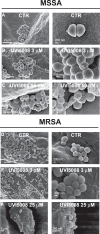Epigenetic modulator UVI5008 inhibits MRSA by interfering with bacterial gyrase
- PMID: 30177735
- PMCID: PMC6120918
- DOI: 10.1038/s41598-018-31135-9
Epigenetic modulator UVI5008 inhibits MRSA by interfering with bacterial gyrase
Abstract
The impact of multi-drug resistant bacterial strains on human health is reaching worrisome levels. Over 2 million people are infected by resistant bacteria, and more than 700,000 people die each year because of the continuous spread of resistant strains. The development of new antibiotics and the prudent use of existing ones to prolong their lifespan require a constant effort by drug industries and healthcare workers. The re-purposing of existing drugs for use as antimicrobial agents would streamline the development of new antibacterial strategies. As part of this effort, we screened a panel of drugs previously characterized to be epigenetic modulators/pro-apoptotic/differentiative drugs. We selected a few compounds that alter Gram-positive growth. Among these, UVI5008, a derivative of the natural compound psammaplin A (Psa_A), was identified. The interaction of Psa_A with the DNA gyrase enzyme has been shown, and here, we hypothesized and confirmed the gyrase-specific activity by biochemical assays. UVI5008 exhibited growth inhibition activity against Staphylococcus aureus via structural modification of the cell wall, which was observed by SEM electron microscopy. Based on our findings, we propose UVI5008 as an alternative antibacterial compound against methicillin-resistant (Met.R) S. aureus strains.
Conflict of interest statement
The authors declare no competing interests.
Figures







References
Publication types
MeSH terms
Substances
LinkOut - more resources
Full Text Sources
Other Literature Sources
Medical
Molecular Biology Databases
Research Materials
Miscellaneous

